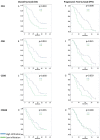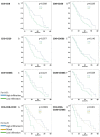Prognostic Impact of Tumor-Infiltrating Lymphocytes and Neutrophils on Survival of Patients with Upfront Resection of Pancreatic Cancer
- PMID: 30609853
- PMCID: PMC6356339
- DOI: 10.3390/cancers11010039
Prognostic Impact of Tumor-Infiltrating Lymphocytes and Neutrophils on Survival of Patients with Upfront Resection of Pancreatic Cancer
Abstract
In patients with pancreatic ductal adenocarcinoma (PDAC), the tumor microenvironment consists of cellular and stromal components that influence prognosis. Hence, tumor-infiltrating lymphocytes (TILs) may predict prognosis more precisely than conventional staging systems. Studies on the impact of TILs are heterogeneous and further research is needed. Therefore, this study aims to point out the importance of peritumoral TILs, tumor-infiltrating neutrophils (TINs), and immune subtype classification in PDAC. Material from 57 patients was analyzed with immunohistochemistry performed for CD3, CD8, CD20, CD66b, α-sma, and collagen. Hot spots with peritumoral TILs and TINs were quantified according to the QTiS algorithm and the distance of TILs hot spots to the tumor front was measured. Results were correlated with overall (OS) and progression-free survival (PFS). High densities of peritumoral hot spots with CD3⁺, CD8⁺, and CD20⁺ TILs correlated significantly with improved OS and PFS. Combined immune cell subtypes predicted improved OS and PFS. High infiltration of CD3⁺ TILs predicted progression after 12 months. The location of TILs' hot spots and their distance to the tumor front did not correlate with patient survival. Peritumoral TILs and the composition of the stroma predict OS and PFS in PDAC.
Keywords: activated stroma index; immune cell infiltration; immune infiltrate; immunoscore; immunosuppression; pancreatic ductal adenocarcinoma; quantification of the tumor immune stroma (QTiS); tumor microenvironment; tumor-infiltrating lymphocytes.
Conflict of interest statement
The authors declare no conflict of interest.
Figures





Similar articles
-
The prognostic value of tumour-infiltrating lymphocytes in pancreatic cancer: a systematic review and meta-analysis.Eur J Cancer. 2020 Jun;132:71-84. doi: 10.1016/j.ejca.2020.03.013. Epub 2020 Apr 22. Eur J Cancer. 2020. PMID: 32334338
-
Development of a reliable and accurate algorithm to quantify the tumor immune stroma (QTiS) across tumor types.Oncotarget. 2017 Dec 4;8(70):114935-114944. doi: 10.18632/oncotarget.22932. eCollection 2017 Dec 29. Oncotarget. 2017. PMID: 29383131 Free PMC article.
-
Clinical Impact of the Immune Microenvironment in Spinal Chordoma: Immunoscore as an Independent Favorable Prognostic Factor.Neurosurgery. 2019 Jun 1;84(6):E318-E333. doi: 10.1093/neuros/nyy274. Neurosurgery. 2019. PMID: 30032257
-
The association between CD3+ and CD8+tumor-infiltrating lymphocytes (TILs) and prognosis in patients with pancreatic adenocarcinoma.Cancer Treat Res Commun. 2023;35:100699. doi: 10.1016/j.ctarc.2023.100699. Epub 2023 Mar 25. Cancer Treat Res Commun. 2023. PMID: 36996584
-
The prognostic value of tumor-infiltrating lymphocytes in colorectal cancer differs by anatomical subsite: a systematic review and meta-analysis.World J Surg Oncol. 2019 May 22;17(1):85. doi: 10.1186/s12957-019-1621-9. World J Surg Oncol. 2019. PMID: 31118034 Free PMC article.
Cited by
-
YOD1 serves as a potential prognostic biomarker for pancreatic cancer.Cancer Cell Int. 2022 May 31;22(1):203. doi: 10.1186/s12935-022-02616-9. Cancer Cell Int. 2022. PMID: 35642058 Free PMC article.
-
An Immunological Glance on Pancreatic Ductal Adenocarcinoma.Int J Mol Sci. 2020 May 8;21(9):3345. doi: 10.3390/ijms21093345. Int J Mol Sci. 2020. PMID: 32397303 Free PMC article. Review.
-
An integrative microenvironment approach for laryngeal carcinoma: the role of immune/methylation/autophagy signatures on disease clinical prognosis and single-cell genotypes.J Cancer. 2021 May 13;12(14):4148-4171. doi: 10.7150/jca.58076. eCollection 2021. J Cancer. 2021. PMID: 34093817 Free PMC article.
-
Immature stroma and high infiltration of CD15+ cells are predictive markers of poor prognosis in different subsets of patients with pancreatic cancer.Cancer Sci. 2024 Mar;115(3):1001-1013. doi: 10.1111/cas.16060. Epub 2024 Jan 17. Cancer Sci. 2024. PMID: 38230840 Free PMC article.
-
Gut-derived lipopolysaccharide remodels tumoral microenvironment and synergizes with PD-L1 checkpoint blockade via TLR4/MyD88/AKT/NF-κB pathway in pancreatic cancer.Cell Death Dis. 2021 Oct 30;12(11):1033. doi: 10.1038/s41419-021-04293-4. Cell Death Dis. 2021. PMID: 34718325 Free PMC article.
References
Grants and funding
LinkOut - more resources
Full Text Sources
Research Materials

